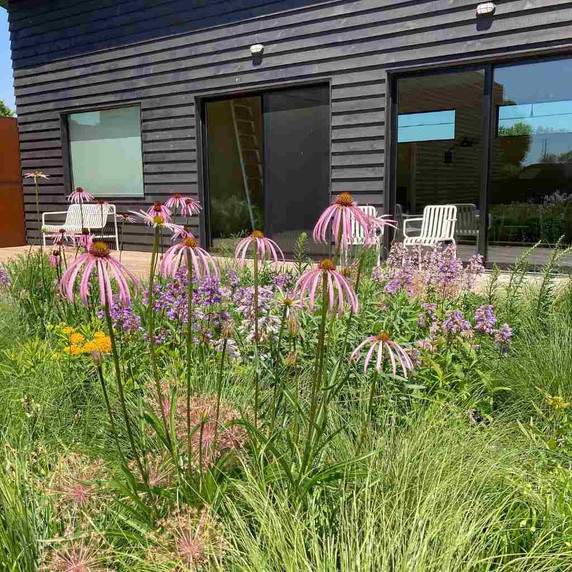Echinacea simulata - GLADE CONEFLOWER
Very similar to Echinacea pallida (simulata = similar).
Drooping petals remind of ballerina dress, fragrant flowers.
Long-lived perennial with a tap root, slender habitus, and narrow hairy leaves.
Very drought, heat and humidity tolerant.
The differences from E. pallida are often more intense flower color, yellow pollen (pallida has white pollen) and starts blooming about 1 week earlier than pallida.
Blooming Time: main flowering period is June – July; with sporadic re-blooming till August/September, but with small amounts of flowers. Deadheading can extend the blooming time, but removes the desirable seeds.
Size: 3’ high x 1-1.5’ wide
USDA Zones: 5 to 8
Culture: sun, tolerates half shade, if the soil is drained! Average garden soil, drained soil, rocky soil, poor soil, infertile and sand soil, slopes, gritty soils. Avoid moist and waterlogged soils.
Moisture Needs: dry, medium-dry, medium
Origin: native wildflower to Illinois, Indiana, Kentucky, Tennessee, Missouri, Arkansas, Alabama and Georgia. Can be found in prairies, slopes, meadows, glades - often on rocky, shallow or dry soils.
Deer/Rabbit Resistant: yes/yes (coarse leaves may still be palatable to cattle)
Attracts Butterflies or Pollinators: long and short-tongued native bees, including bumble bees, honey bees, butterflies, and skippers. Host plant for caterpillars of some moths
Attracts Hummingbirds: hummingbirds occasionally feed on the nectar, goldfinches eat the seeds
Pot Size: square 3.5" x 4" deep perennial pot
Plant combinations: naturalistic garden, native gardens, pollinator gardens, bird gardens, xeric site (dry), deer resistant plantings, slopes that tend to dry out, shallow unfertile and dry soils and beds, drier prairie plantings. Looks great when combined with fine flowering grasses Koeleria macrantha, Muhlenbergia, Panicum, Sorghastrum, Stipa tenuissima, Sporobolus heterolepis, and others.
For other good perennial combinations, add native perennials like Artemisia, Agastache (‘Blue Fortune’ , A. nepetoides), Asclepias tuberosa, Baptisia, Callirhoe, Coreopsis, Eryngium, Penstemon, Pycnanthemum, Liatris, Silphium terenbinthinaceum .This Echinacea looks good when combined with plants that remind of thistles, such as these non-native perennials: any Eryngium (E. planum, E. giganteum ' Big Blue',…), Echinops, Knautia macedonica, but also with Geranium sanquineum, Perovskia or Salvia nemorosa.
Pictures copyright: Ben O'Brien, Wild By Design

Echinacea simulata - GLADE CONEFLOWER
Very similar to Echinacea pallida (simulata = similar).
Drooping petals remind of ballerina dress, fragrant flowers.
Long-lived perennial with a tap root, slender habitus, and narrow hairy leaves.
Very drought, heat and humidity tolerant.
The differences from E. pallida are often more intense flower color, yellow pollen (pallida has white pollen) and starts blooming about 1 week earlier than pallida.
Blooming Time: main flowering period is June – July; with sporadic re-blooming till August/September, but with small amounts of flowers. Deadheading can extend the blooming time, but removes the desirable seeds.
Size: 3’ high x 1-1.5’ wide
USDA Zones: 5 to 8
Culture: sun, tolerates half shade, if the soil is drained! Average garden soil, drained soil, rocky soil, poor soil, infertile and sand soil, slopes, gritty soils. Avoid moist and waterlogged soils.
Moisture Needs: dry, medium-dry, medium
Origin: native wildflower to Illinois, Indiana, Kentucky, Tennessee, Missouri, Arkansas, Alabama and Georgia. Can be found in prairies, slopes, meadows, glades - often on rocky, shallow or dry soils.
Deer/Rabbit Resistant: yes/yes (coarse leaves may still be palatable to cattle)
Attracts Butterflies or Pollinators: long and short-tongued native bees, including bumble bees, honey bees, butterflies, and skippers. Host plant for caterpillars of some moths
Attracts Hummingbirds: hummingbirds occasionally feed on the nectar, goldfinches eat the seeds
Pot Size: square 3.5" x 4" deep perennial pot
Plant combinations: naturalistic garden, native gardens, pollinator gardens, bird gardens, xeric site (dry), deer resistant plantings, slopes that tend to dry out, shallow unfertile and dry soils and beds, drier prairie plantings. Looks great when combined with fine flowering grasses Koeleria macrantha, Muhlenbergia, Panicum, Sorghastrum, Stipa tenuissima, Sporobolus heterolepis, and others.
For other good perennial combinations, add native perennials like Artemisia, Agastache (‘Blue Fortune’ , A. nepetoides), Asclepias tuberosa, Baptisia, Callirhoe, Coreopsis, Eryngium, Penstemon, Pycnanthemum, Liatris, Silphium terenbinthinaceum .This Echinacea looks good when combined with plants that remind of thistles, such as these non-native perennials: any Eryngium (E. planum, E. giganteum ' Big Blue',…), Echinops, Knautia macedonica, but also with Geranium sanquineum, Perovskia or Salvia nemorosa.
Pictures copyright: Ben O'Brien, Wild By Design




